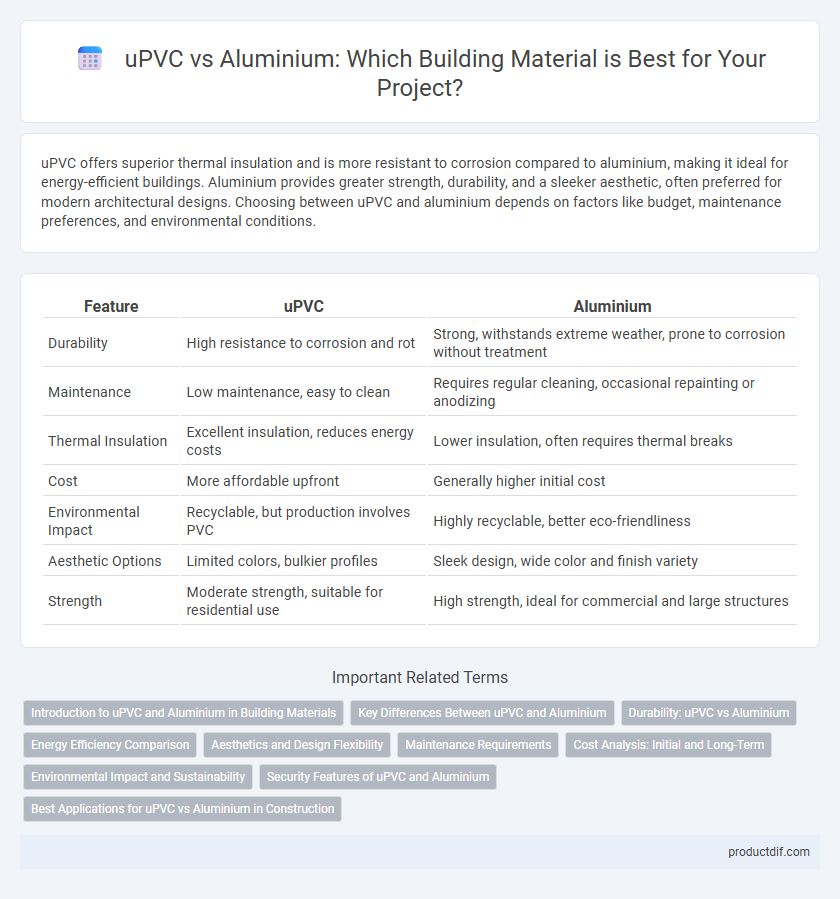uPVC offers superior thermal insulation and is more resistant to corrosion compared to aluminium, making it ideal for energy-efficient buildings. Aluminium provides greater strength, durability, and a sleeker aesthetic, often preferred for modern architectural designs. Choosing between uPVC and aluminium depends on factors like budget, maintenance preferences, and environmental conditions.
Table of Comparison
| Feature | uPVC | Aluminium |
|---|---|---|
| Durability | High resistance to corrosion and rot | Strong, withstands extreme weather, prone to corrosion without treatment |
| Maintenance | Low maintenance, easy to clean | Requires regular cleaning, occasional repainting or anodizing |
| Thermal Insulation | Excellent insulation, reduces energy costs | Lower insulation, often requires thermal breaks |
| Cost | More affordable upfront | Generally higher initial cost |
| Environmental Impact | Recyclable, but production involves PVC | Highly recyclable, better eco-friendliness |
| Aesthetic Options | Limited colors, bulkier profiles | Sleek design, wide color and finish variety |
| Strength | Moderate strength, suitable for residential use | High strength, ideal for commercial and large structures |
Introduction to uPVC and Aluminium in Building Materials
uPVC, or unplasticized polyvinyl chloride, is a highly durable and low-maintenance material widely used for window frames, doors, and piping due to its excellent thermal insulation and resistance to corrosion. Aluminium, valued for its strength-to-weight ratio and recyclability, is commonly employed in structural frameworks, curtain walls, and window systems where structural integrity and modern aesthetics are essential. Both materials offer distinct advantages in building applications, with uPVC excelling in energy efficiency and cost-effectiveness, while aluminium provides superior durability and design flexibility.
Key Differences Between uPVC and Aluminium
uPVC offers excellent thermal insulation and is highly resistant to corrosion, making it energy-efficient and low-maintenance for window and door frames. Aluminium is stronger and more durable, providing greater structural stability and allowing for slimmer profiles with larger glass areas. Cost-wise, uPVC is generally more affordable, while aluminium commands a higher price due to its premium strength and longevity.
Durability: uPVC vs Aluminium
uPVC offers excellent resistance to corrosion, moisture, and weathering, making it highly durable in humid and coastal environments without rusting or fading. Aluminium provides superior strength and withstands high impact forces, but it may require regular maintenance to prevent oxidation and corrosion over time. Both materials exhibit long-lasting performance, yet uPVC is often preferred for its low maintenance and aluminium for structural robustness.
Energy Efficiency Comparison
uPVC windows provide superior thermal insulation due to their low thermal conductivity, reducing heat loss and enhancing overall energy efficiency in buildings. Aluminium frames conduct heat more readily, often resulting in higher energy costs unless fitted with thermal breaks to improve insulation. Choosing uPVC can significantly lower heating and cooling expenses, contributing to sustainable building practices and compliance with energy efficiency standards.
Aesthetics and Design Flexibility
uPVC offers a range of customizable colors and finishes with smooth surfaces that maintain appearance over time, ideal for traditional and modern aesthetics. Aluminium provides superior design flexibility, enabling slim profiles, larger glass panes, and complex shapes, appealing to contemporary architectural styles. Both materials ensure durability, but aluminium's strength allows for more innovative and sleek design possibilities.
Maintenance Requirements
uPVC windows require minimal maintenance due to their resistance to rot, corrosion, and fading, needing only occasional cleaning with soap and water. Aluminium frames demand more upkeep to prevent oxidation and maintain their protective coatings, especially in coastal or humid environments. Regular inspections and repainting or resealing are often necessary to preserve aluminium's durability and aesthetic appeal.
Cost Analysis: Initial and Long-Term
uPVC windows offer a lower initial cost compared to aluminium, making them a budget-friendly option for new construction or remodeling projects. Over the long term, uPVC requires minimal maintenance with excellent durability, resulting in reduced upkeep expenses. Aluminium, while more expensive upfront, provides superior strength and longevity, which can translate into long-term savings on replacements and repairs in harsh environmental conditions.
Environmental Impact and Sustainability
uPVC offers superior energy efficiency due to its excellent thermal insulation properties, contributing to reduced carbon emissions in buildings. Aluminium, while highly durable and recyclable, has a higher embodied energy and carbon footprint from extraction and manufacturing. Sustainable construction often favors uPVC for its lower environmental impact, though aluminium's recyclability supports circular economy goals in long-term use.
Security Features of uPVC and Aluminium
uPVC offers superior security with multi-point locking systems and reinforced steel cores, enhancing resistance to forced entry. Aluminium frames provide robust security due to their strength and durability, often integrated with high-performance locks and anti-pry features. Both materials can be customized for enhanced protection, but uPVC typically offers better thermal insulation alongside security benefits.
Best Applications for uPVC vs Aluminium in Construction
uPVC excels in residential construction for window frames and doors due to its excellent thermal insulation, low maintenance, and cost-effectiveness. Aluminium is preferred in commercial buildings and high-rise structures because of its strength, lightweight properties, and superior resistance to corrosion and weathering. Combining both materials in construction projects optimizes performance by leveraging uPVC's energy efficiency and aluminium's structural durability.
uPVC vs Aluminium Infographic

 productdif.com
productdif.com